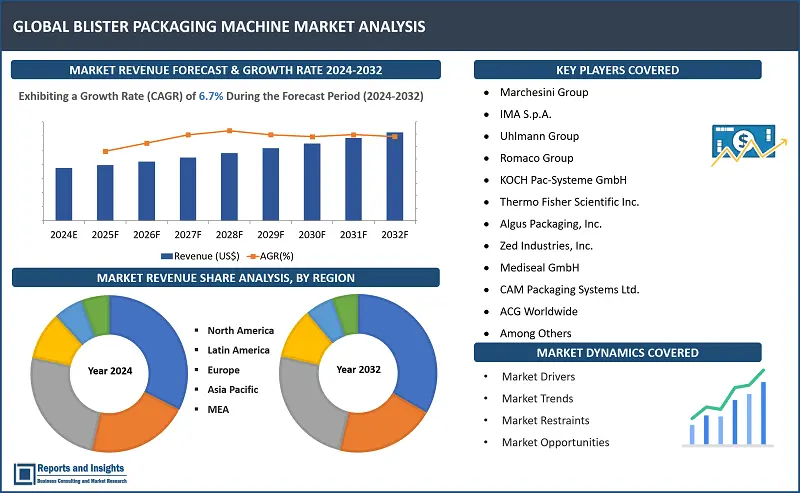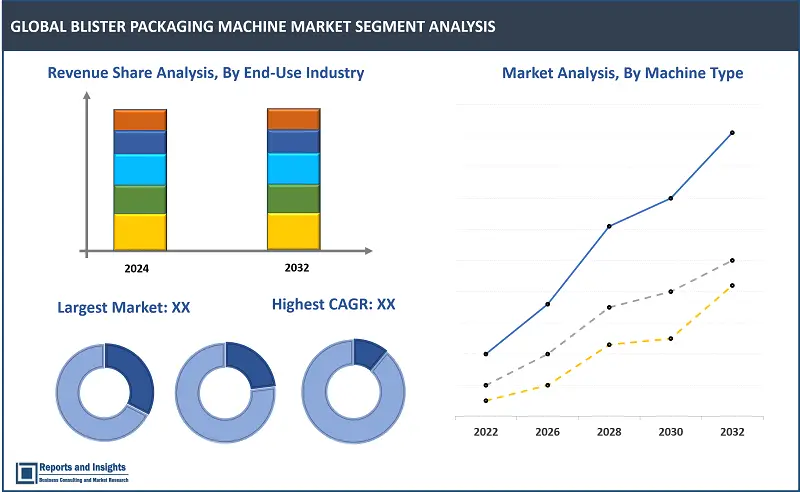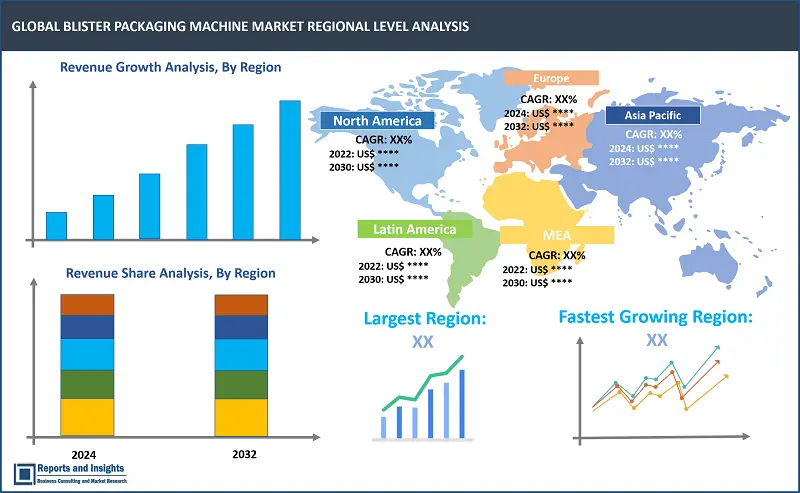Market Overview:
"The global blister packaging machine market size reached US$ 910.2 million in 2023. Looking forward, Reports and Insights expects the market to reach US$ 1,631.6 million in 2032, exhibiting a growth rate (CAGR) of 6.7% during 2024-2032."
|
Report Attributes |
Details |
|
Base Year |
2023 |
|
Forecast Years |
2024-2032 |
|
Historical Years |
2021-2023 |
|
Market Growth Rate (2024-2032) |
6.7% |
Blister packaging and sealing machines play a pivotal role in the packaging industry, offering efficient and secure containment for various products across diverse industries such as pharmaceuticals, nutraceuticals, consumer goods, electronics, and cosmetics. The benefits of blister packaging include enhanced product protection, extended shelf life, and improved visibility for branding. Advantages such as cost-effectiveness and reduced environmental impact further contribute to the widespread adoption of blister packaging solutions.
Steady shift towards automation across industries is driving development of more sophisticated automatic blister packing machines. Integration of smart technologies and focus on sustainable materials align with the commitment various industries to environmental responsibility. The global blister packaging machines market continues to witness key developments, including the introduction of high-speed machines, intelligent control systems, and customized solutions to cater to the diverse needs of various end-use industries. As the market evolves, the emphasis on precision, speed, and sustainability remains paramount in shaping the future of blister packaging technology.

Blister Packaging Machine Market Trends and Drivers
Adoption of blister packaging machines is being driven by increasing demand for efficient and secure packaging solutions across diverse industries, such as pharmaceuticals, nutraceuticals, electronics, and cosmetics. Rising emphasis on product safety and integrity also contributes significantly to preference for blister packaging. The trend towards automation in manufacturing processes is also a significant driver, as this approach not only enhances production efficiency, but also minimizes errors, resulting in consistent and high-quality blister packaging. Contemporary blister packaging machinery provides accurate management of manufacturing parameters, usually operated by Programmable Logic Controller (PLC) systems. Adjustments to these values are conveniently made through the Human Machine Interface (HMI), facilitating seamless setup and fine-tuning processes.
Advancements in blister packaging technology, materials, and integration of Artificial Intelligence (AI) and Machine Learning (ML) has been resulting in more expansive control of various processes, defect detection, blister counting, quality, and productivity in recent times. Machines are being designed to enhance the packaging process, ensuring accuracy, speed, and adherence to the highest quality standards owing to ability of these technological advancements transforming traditional packing machines into intelligent, data-driven systems, with ability to adapt, learn, and optimize processes.
In addition, rising focus on sustainability is shaping the market, with incorporation of eco-friendly and recyclable and compostable mono materials, paperboard, fibers, and biodegradable plastics aligning with the global shift towards environmentally conscious practices, and appealing to both manufacturers and consumers. More advanced machines being developed and introduced on the market offer advantages of predictive maintenance for optimal performance, enhanced quality control and error detection, adaptive packaging solutions, and streamlined operations and resource efficiency. Packaging machines are currently being designed to optimize packaging layouts, reduce material usage, optimize energy consumption, and minimize environmental impact and carbon footprint.
Moreover, the versatility of blister packaging machines in accommodating various product types, including solid, liquid, and powder forms, supports their widespread adoption. The ability to cater to diverse packaging needs enhances applicability of these machines across various industries, and increased adoption is contributing to the overall growth and evolution of the global blister packaging machines market.
Blister Packaging Machine Market Restraining Factors
Substantial initial investment required for acquiring and implementing advanced blister packaging technologies and machinery poses a financial barrier for some businesses, especially small and medium-sized enterprises. The complexity of operating and maintaining these machines may also hamper adoption, as it necessitates skilled personnel and specialized training. In addition, regulatory compliance challenges in different industries can slow down the adoption rate, given the stringent standards for packaging in sectors such as pharmaceuticals and nutraceuticals. Also, blister packaging machines require regular maintenance, and associated costs can impact profit margins to some extent.
Other factors include the environmental concerns associated with excessive packaging waste, impacting the market due to the need for more sustainable alternatives. Blister packs typically contain both metal and plastic, and Polyvinyl Chloride (PVC) is not widely recycled and can contaminate recycling bundles.
Blister Packaging Machine Market Opportunities
Leading players in the global blister packaging machines market can innovate to cater to increasing demand for pharmaceutical blister packaging, driven by the rising healthcare needs globally. Stringent standards and continuously changing regulatory compliance related to drugs and similar products and equipment and devices and high focus on patient safety is driving need for more advanced blister packaging solutions. This supports need for continuous innovation and presents opportunity for companies operating in this market to create new pharmaceutical packaging techniques, adopt safe and sustainable materials, and drive competition.
Also, the expanding e-commerce sector offers a lucrative opportunity, with the need for secure and tamper-evident packaging solutions. As online retail expands rapidly, companies can focus on developing blister packaging machines to cater to the unique packaging requirements of various products and open-up new prospects. Rising emphasis on sustainable packaging practices provides an opportunity for companies to develop eco-friendly blister packaging solutions, and reduce waste and support recycling efforts. In addition, the integration of smart technologies and Industry 4.0 concepts in blister packaging machines opens avenues for innovation and enhanced efficiency, meeting the evolving needs of the market. Moreover, collaborations and strategic partnerships with key stakeholders in the supply chain can create synergies, enabling companies to offer comprehensive solutions and expand their market presence.
Blister Packaging Machine Market Segmentation

By Machine Type
- Roller Blister Packaging Machine
- Flat Forming Blister Packing Machine
- Roller Plate Blister Packaging Machine
The roller blister packaging machine segment is expected to account for largest revenue share over the forecast period. This projection is substantiated by the superior efficiency of roller blister packaging machines in meeting various packaging requirements, including adaptability to different product forms. The versatility, precision, and high-speed capabilities of roller blister packaging machines make these a preferred choice for industries seeking enhanced productivity and meeting varying market needs.
By Operation Type
- Manual Blister Packing Machines
- Semi-Automatic Blister Packing Machines
- Automatic Blister Packing Machines
The automatic blister packing machines segment is expected to account for largest revenue share among the operation type segments over the forecast period. This can be attributed to increasing demand for streamlined and high-speed packaging processes, where automatic machines offer significant advantages in terms of efficiency and reduced labor costs. The automation trend in manufacturing, coupled with rising emphasis on precision and consistency, positions automatic blister packing machines as a preferred choice in the current market scenario.
By Product Forms
- Solid Products Blister Packaging Machines
- Liquid Products Blister Packaging Machines
- Powder Products Blister Packaging Machines
Among the product forms segments, the solid products blister packaging machines segment is projected to maintain dominate in terms of revenue share, driven by higher demand for solid products, including pharmaceuticals, consumer goods, and electronics. The versatility of solid products blister packaging machines in packaging a broad range of solid items aligns with the diverse packaging needs across sectors, is contributing to significantly high demand.
By End-Use Industry
- Pharmaceutical
- Nutraceuticals
- Consumer Goods
- Electronics
- Cosmetics and Personal Care
The pharmaceutical segment is expected to account for largest revenue share among the end-use industry segments. This projection is supported by the critical role of blister packaging in the pharmaceutical industry to ensure product integrity, tamper resistance, and compliance with stringent regulations.
By Region

North America
- United States
- Canada
Europe
- Germany
- United Kingdom
- France
- Italy
- Spain
- Russia
- Poland
- Benelux
- Nordic
- Rest of Europe
Asia Pacific
- China
- Japan
- India
- South Korea
- ASEAN
- Australia & New Zealand
- Rest of Asia Pacific
Latin America
- Brazil
- Mexico
- Argentina
Middle East & Africa
- Saudi Arabia
- South Africa
- United Arab Emirates
- Israel
- Rest of MEA
The global blister packaging machine market is divided into five key regions: North America, Europe, Asia Pacific, Latin America, and the Middle East and Africa. North America, Asia Pacific, and Europe have been key regions in the packaging machinery market. In North America, the market share contribution is particularly high from the United States due to a robust pharmaceutical industry and strong focus on technological innovation. In Asia Pacific, countries such as China and India have been registering significantly rapid revenue growth in the packaging machinery market, driven by expanding manufacturing activities and increasing demand in various end-use industries. In Europe, demand is relatively high from Germany, which has a well-established manufacturing sector and a high emphasis on quality packaging.
Some common factors driving growth of the blister packaging machines market in major countries in these regions include increasing demand for pharmaceuticals, driven by rising healthcare needs, technological advancements and ongoing innovations in blister packaging machines, and focus on sustainable packaging approaches and technologies and exploration and use of eco-friendly materials.
Leading Blister Packaging Machine Manufacturers & Competitive Landscape:
The competitive landscape in the global blister packaging machines market is marked by intense rivalry among leading companies striving to maintain their positions and expand their consumer base. Key strategies employed include continuous technological innovation to enhance machine efficiency, speed, and versatility. For instance, Jornen Machinery launched a new generation of high-speed blister packaging machine in August 2023, with each station featuring an independent servo system, which enables convenient production variety switching.
Companies also invest significantly in research and development to introduce advanced features, automation, and smart technologies, catering to the evolving needs of end-use industries. Strategic collaborations and partnerships with other industry players and stakeholders are common, fostering a collaborative ecosystem for mutual growth.
Also, market leaders focus on providing comprehensive solutions and services, offering customization to meet specific client requirements. Robust marketing strategies, such as product promotions, participation in industry events, and digital outreach, are also employed to raise brand visibility and attract new customers. Overall, the competitive landscape reflects a dynamic environment where innovation, strategic alliances, and customer-centric approaches play pivotal roles in sustaining and expanding market positions.
These companies include:
- Marchesini Group
- IMA S.p.A.
- Uhlmann Group
- Romaco Group
- KOCH Pac-Systeme GmbH
- Thermo Fisher Scientific Inc.
- Algus Packaging, Inc.
- Zed Industries, Inc.
- Mediseal GmbH
- CAM Packaging Systems Ltd.
- ACG Worldwide
- Bosch Packaging Technology
- IWK Verpackungstechnik GmbH
- Fabrima
- Starview Packaging Machinery, Inc.
Recent Development:
- August 2023: Jornen Machinery Co., Ltd. launched an advanced high-speed blister packaging machine featuring independent servo systems at each station. The machine facilitates seamless production variety switching, and has two layers effectively reducing its length. The machine offers options for rotary or platen sealing styles to cater to diverse customer preferences.
- January 2023: Romaco Noack introduced the Unity 600 blister packaging line, with a maximum output of 600 blisters and 350 cartons per minute. This launch is geared towards enhancing efficiency and minimizing emissions in pharmaceutical and nutraceutical pack production. The machine incorporates a double-lane high-speed configuration, featuring a blister machine with rotary sealing and a continuous motion cartoner. Also, it comes with a transfer unit prioritizes higher cycle numbers, format flexibility, traceability, and energy efficiency. With a commitment to reducing the carbon footprint both in manufacturing and operation, the line is equipped with an energy monitor, measuring power and air consumption, along with CO2 emissions during production.
Blister Packaging Machine Market Research Scope
|
Report Metric |
Report Details |
|
Market size available for the years |
2021-2023 |
|
Base Year |
2023 |
|
Forecast Period |
2024-2032 |
|
Compound Annual Growth Rate (CAGR) |
6.7% |
|
Segment covered |
Machine Type, Operation Type, Product Forms, End-Use Industry |
|
Regions Covered |
North America: The U.S. Canada Latin America: Brazil, Mexico, Argentina, Rest of Latin America Asia Pacific: China, India, Japan, Australia New Zealand, ASEAN, & Rest of Asia Pacific Europe: Germany, The U.K., France, Spain, Italy, Russia, Poland, BENELUX, NORDIC, & Rest of Europe The Middle East & Africa: Saudi Arabia, United Arab Emirates, South Africa, Egypt, Israel, and Rest of MEA |
|
Fastest Growing Country in Asia Pacific |
China |
|
Largest Market in Europe |
Germany |
|
Key Players |
Marchesini Group, IMA S.p.A., Uhlmann Group, KOCH Pac-Systeme GmbH, Romaco Group, Thermo Fisher Scientific Inc., Algus Packaging, Inc., Zed Industries, Inc., Mediseal GmbH, CAM Packaging Systems Ltd., ACG Worldwide, Bosch Packaging Technology, IWK Verpackungstechnik GmbH, Fabrima, Starview Packaging Machinery, Inc. |
Frequently Asked Question
What are some key factors driving revenue growth of the global blister machine market?
Some key factors driving market revenue growth include increasing demand for efficient packaging solutions, technological advancements in blister machine technology, stringent regulations on product safety and hygiene, growing focus on sustainability, and the rise of e-commerce.
Which end-use industries contribute majorly in terms of demand for blister machines?
The pharmaceutical industry, food and beverage industry, consumer goods industry, electronics industry, and cosmetics and personal care industry are major contributors to demand for blister machines.
What are some emerging trends in the global blister machine market?
Some emerging trends in the market include the adoption of sustainable packaging solutions, customization and personalization options, digital integration with IoT and data analytics, increasing automation, and the integration of intelligent controls.
How is the competitive landscape of the global blister machine market?
The competitive landscape is characterized by a mix of established players and emerging companies. Key manufacturers compete based on factors like product innovation, technological advancements, customization capabilities, and after-sales services. Strategic partnerships, acquisitions, and expanding product portfolios are common strategies employed by market players.
What regions and countries hold significant potential in the global blister machine market?
Regions such as North America, Europe, Asia Pacific, and Latin America exhibit significant potential. Countries like the US, Germany, China, and Brazil have seen notable developments, driving product sales and demand. Factors such as market share, revenue growth, consumer preference, industry growth, developments, and government initiatives influence their potential in the market.

